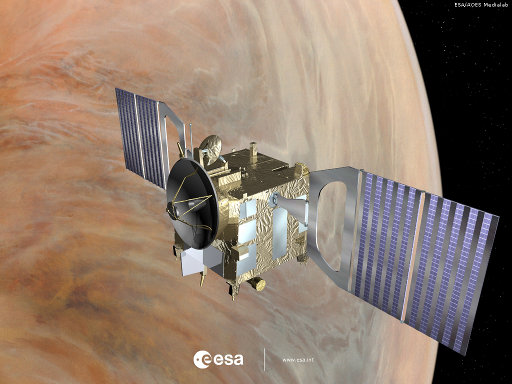
ESA Venus Express space probe was launched on November 9, 2005 and entered Venus orbit on April, 11 2006. Initially, it was proposed as a reuse of the Mars Express project then it underwent various changes to adapt it to the research on Venus, a planet very different from Mars and much closer to the Sun. Its original mission lasted just over a year, then ESA approved two extensions to reach the end of 2012.
One of the main instruments of the spacecraft Venus Express is the VIRTIS (Visible and InfraRed Thermal Imaging Spectrometer), an imaging spectrometer developed for the mission of another ESA spacecraft, Rosetta.
Using the VIRTIS at infrared waves, the space probe Venus Express can study the surface of Venus despite the thick layer of clouds that cover it. Studies of this kind had already been made in the ’80s and ’90s by the Venera spacecraft and in particular by the Magellan space probe, which created the first high resolution map of the surface of Venus.
During the Venus Express spacecraft mapping, scientists realized that some elements of the surface of Venus which were already known were displaced up to twenty kilometers from the position where they were supposed to be according to the measurement of the planet’s rotation made by the Magellan spacecraft, which established that a Venusian day was equal to 243.0185 Earth days.
Obviously, the first thing scientists did after this surprising result was to check all the calculations based on the measurements of the Venus Express spacecraft because those made in the past by the Magellan spacecraft were accurate. The new calculations however confirmed that the Venus’ day seems to have become about 6.5 minutes longer in the 16 years between the two measurements.
[ad name=”AmazonScience”]
These measurements will help scientists better understand the nature of Venus and its history. If Venus has a solid core, its mass should be more concentrated towards the center and in this case the planet’s rotation will be influenced to a lesser extent by external forces.
On Venus, atmospheric forces are very important because the planet’s atmosphere is extremely dense, so much that its pressure is more than ninety times the Earth’s. Venus is also characterized by high speed winds and in accordance with new atmospheric models there may be weather cycles that last decades. Those phenomena may cause such friction on the surface of the planet to slow its rotation.
Discovering why the Venus’ day is so long and at the same time the surface winds have high speeds but also understanding the greenhouse effect the makes Venus hell are the major objectives of the Venus Express space mission. The search continues and now among the data there’s also Venus’ slow rotation to solve the mysteries of a planet which in some ways is the Earth’s twin yet it’s so different from it.


Permalink